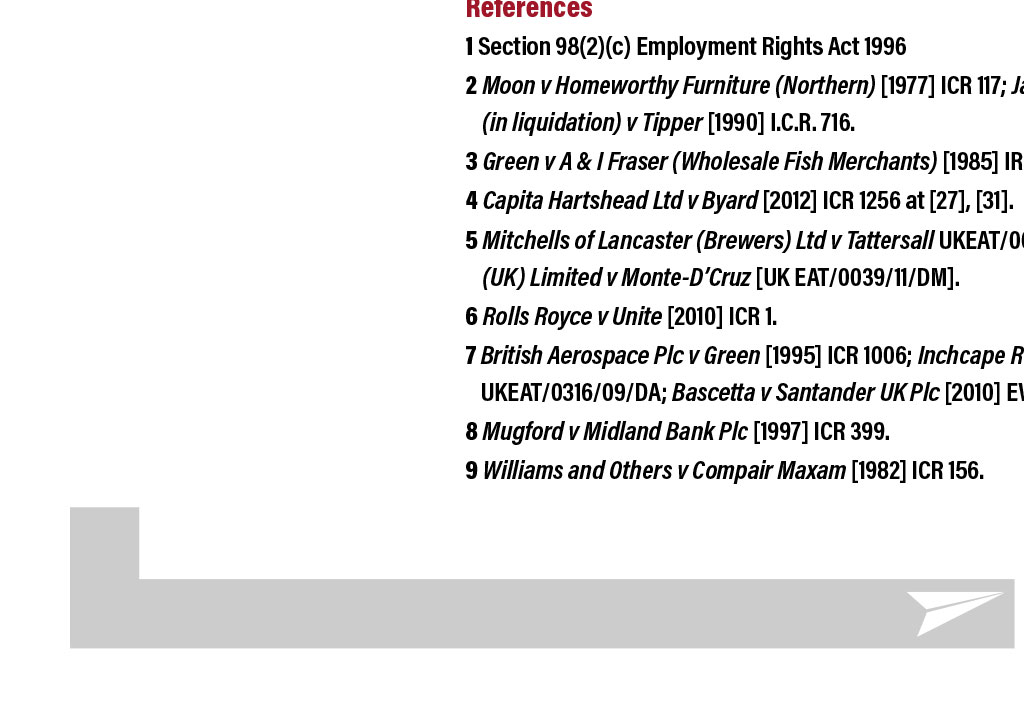




























By Stuart Brittenden, barrister and employment law specialist s part of the Legal Services Sub Committees (LSSCs) updates to members, we invite professional legal experts in their field to tell us as it is on those aspects of the law that affect pilots. Over the past few months, many of our colleagues have been made redundant. We may even have been threatened with redundancy ourselves, but been lucky so far to avoid it. We must all have been thinking about it and how/if we might be affected. So, it is surprising to hear of the many misconceptions we have had reported back to BALPA and the LSSC about redundancy, what the law says about it, and how redundancy law works in practice. Selection Redundancy is one of the five specified potentially fair reasons for dismissal1 the others being capability, conduct, legislation and qualification. However, the label unfair dismissal often gives rise to misunderstanding by the lay person. To better understand an unfair dismissal, it is useful to identify the ground rules governing this important area of law. The test of unfairness is not all-encompassing, but instead quite narrowly applied. Simply put, the Employment Tribunal (ET) will consider whether or not the dismissal fell within the range of reasonable responses open to the employer. This means that the ET is not allowed to stand in the employers shoes and decide how it would have approached the situation. Rather, the test is different it recognises that there is a band of reasonable behaviour; two employers may approach the same situation differently, but both may well be acting fairly. The points that frequently emerge relate to: Couldnt the employer have made savings elsewhere? The choice of pool Fairness of the selection criteria Unfair application of the criteria through missed opportunities for example, I couldnt change type rating because I was on holiday, or the course was cancelled, or I had a bug Provision of sufficient information and consultation. Economic choices An ET is not permitted to scrutinise the business decision taken by the employer or find that the employer should have adopted a different course of action by making savings elsewhere. It is not permitted to interfere with the management prerogative to manage its affairs as it considers most appropriate2. Pool It is the employer who has to decide which pilots to include in the pool used to select individuals for redundancy. A common misconception is that the employer must always include everyone who performs a similar job role in the same pool. For example, the argument is often raised that an employer should include all pilots as a single pool, or all captains and first officers in single pools, because they all perform essentially the same duties as pilots. Although that might work in other sectors of industry, it doesnt in the aviation sector think fleets, bases, and relevant training-specific qualifications. The question of the appropriateness of the selection pool is something that also falls to be judged in accordance with the rather hazy band of reasonable responses3. In practice, it is particularly difficult to challenge the employers choice of pool, provided that it has given genuine consideration to how the pool is constructed, and it is capable of some rational justification as to why it made the choice it did. The ET is not permitted to decide whether they would have thought it fairer to act in some other way4. Ultimately, the employer has the final say over choice of pool, if they have some rational justification for what they have done. This means that an employer is allowed to construct one or more pools by reference to its immediate needs, usually by reference to geographical need (by reference to headcount reductions in each base), rank and type rating. Those factors often justify the employer using smaller locality-based pools by reference to fleet requirements. The point is made that if the employer adopts a wider pool, it may incur relocation costs in transferring pilots between bases. Also, it may be left with insufficient numbers of pilots to satisfy its type-rating needs. This will result in further training costs and delay before the pilot can become operational, at a time when it is trying to reduce costs. It is important to understand that a blanket approach is adopted here. It is not usually possible for someone to say that they should be excluded from the pool because they only changed their type rating a few months previously, or had only just passed their Command Course, or had recently changed base following a transfer request. The blanket approach trumps the individual circumstances. Selection criteria Next, the employer has to devise the criteria for selection. Again, it has the final say and can draw upon the criteria to reflect its need going forward, by awarding points for certain qualifications or experience, length of service, good discipline, and other measures of performance, sometimes including previous checks. It is a myth that an employer is only allowed criteria that can be objectively validated. Subjective assessment is permissible, provided that the factors taken into account are reasonable5. Although, traditionally, length of service has been used as an exclusive criterion for selection LIFO (last in, first out) that is now no longer the case. This can give rise to claims of indirect age or sex discrimination if used in isolation (or if given undue weighting in any selection matrix)6. Redundancy is one of the five specified potentially fair reasons for dismissal the others being capability, conduct, legislation and qualification Challenging the scoring Unless something has gone seriously awry in the scoring process, or the scoring has been tainted in a material way (such as clear evidence of bias), it is notoriously difficult to challenge the scores at the ET. It is well established, legally, that an ET is not permitted to closely scrutinise the scores awarded in determining the fairness of a dismissal. The ET is not entitled to embark upon a reassessment exercise, or subject scoring to an over-minute analysis7. The question that the ET has to address is whether the individual was unfairly dismissed, not whether some other employee could have been fairly dismissed. Individual consultation Where a trade union is recognised, collective consultation does not obviate the employers obligation to provide sufficient information to the individual pilot, and to consult with them individually8. Typically, an employer will be expected to advise employees in writing of the situation giving rise to the redundancy situation, inform them of the pools to be used, the headcount reductions to be made, and the selection criteria. The employer will be expected to notify staff if they are placed at risk of redundancy and, if they are, to share their score with them, and respond to any concerns raised about the scores awarded. The employer should invite the employee to a meeting, explain the situation, respond to any questions, and listen to any alternative suggestions that the individual may raise that could avert their dismissal. However, an employer will not be expected to replicate the collective consultation process it has had with a trade union with employees at an individual level. There is no mathematical formula as to how many individual meetings need to be held. The issue is how well the employer keeps the workforce informed of what is happening, what its proposals will entail, and what developments have occurred along the way. It is not uncommon for employers to invite individual employees to raise suggestions or provide comments to a named point of contact during any collective consultation process. Overall, the requirement to keep staff informed and to consult is not an onerous one. It is essentially a question of fact and degree9. Even where an employer does not consult, this may result in a finding of unfair dismissal on procedural grounds. However, where consultation would not have had any material bearing on the outcome, compensation may well be limited to a few weeks pay at most. Alternative employment Finally, before confirming the decision to dismiss, the employer should consider whether there is suitable alternative employment available that can be offered in line with the individuals skills, aptitude and experience. Where there are more displaced pilots than roles available, the employer will not be criticised if it uses the results of the selection matrix to determine who should be offered employment. There is no requirement for an employer to conduct a bumping redundancy situation where a captain who is surplus to requirements displaces a first officer. As with all questions on this area, the issue is whether the employer is acting in accordance with the band of reasonable responses. Some employers may bump, others may not. Both are likely to be acting fairly. Appeals It is good practice to offer employees the chance to appeal. This usually takes the form of a review as opposed to a re-hearing. It is sensible for the appellant to identify clear grounds of appeal or unfairness, and to be able to demonstrate how this had a material bearing on the outcome. In other words, they need to demonstrate that the employer was outside of the band of reasonable responses in making them redundant. Purely academic points of no consequence or making generalised challenges to the pool or the selection criteria are unlikely to carry much weight. This article was written by Stuart Brittenden, a barrister with Old Square Chambers. The information in this article is correct as at the time of writing, 1st March 2021. However, the law changes and evolves, so, if this happens to you, make sure your Company Council and National Officer contact the LSSC to obtain the most up-to-date information available. References 1 Section 98(2)(c) Employment Rights Act 1996 2M oon v Homeworthy Furniture (Northern) [1977] ICR 117; James W Cook & Co (Wivenhoe) Ltd (in liquidation) v Tipper [1990] I.C.R. 716. 3 Green v A & I Fraser (Wholesale Fish Merchants) [1985] IRLR 55. 4 Capita Hartshead Ltd v Byard [2012] ICR 1256 at [27], [31]. 5 Mitchells of Lancaster (Brewers) Ltd v Tattersall UKEAT/0605/11/SM; Samsung Electronics (UK) Limited v Monte-DCruz [UK EAT/0039/11/DM]. 6 Rolls Royce v Unite [2010] ICR 1. 7 British Aerospace Plc v Green [1995] ICR 1006; Inchcape Retail Ltd v Symonds UKEAT/0316/09/DA; Bascetta v Santander UK Plc [2010] EWCA Civ 351. 8 Mugford v Midland Bank Plc [1997] ICR 399. 9 Williams and Others v Compair Maxam [1982] ICR 156. LEG AL Winning and losing